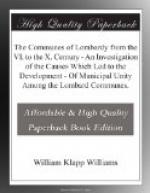The conquerors took possession of the country simply as they would take possession of a larger farm than they had before owned. Their riches were only such as served for the support of men—herds, land, wine and corn. They needed cultivators for their large farm, so instead of destroying every one with fire and sword, they spared those of the weak inhabitants of the land who had survived the first onslaught, in order that they might make use of farmers to cultivate their new possessions. In most cases they did not make slaves of them, but tributaries; and after the land had been portioned evenly among the soldiers of the invading host, the original holders of the land tilled it themselves, under a system somewhat kindred to the metayer system as to-day existent in Tuscany and elsewhere, paying, according to the usual custom adopted by the northern conquerors of Italy, one-third of the produce[1] to their new masters. The whole organization of society was on a purely military basis; the soldiers of the conquering army, although they became landed proprietors, none the less retained their character and name of soldiers. Hence when these crude forms of social life began to crystallize into the carefully marked ranks of the feudal system, the “milites"[2] formed the order of gentlemen, the smaller feudatories, who gave land in fief to their vassals—generally the old inhabitants—while holding their own nominally from the “duces,” or dukes, the representatives of their former leaders in war, who held their tenure direct from the king or chief.
As the object of this paper is particularly to trace the origin and early sources of municipal life in Northern Italy, let us turn and see what were the effects on the already existing towns, of the inroads of these hordes of northern barbarians. At the outset I must state emphatically that all our sources of information as to the institutional history of this obscure period are exceedingly vague, meagre and unsatisfactory. The progress of events we can follow with more or less accuracy from the mazy writings of the early chroniclers; we can get a fair idea of the judicial and the legislative acts of the ruling powers by studying and comparing the different codes of laws that have come down to us; but in a study of the internal municipal life of these early ages, the student meets again and again with increasing discouragement, and soon finds himself almost hopelessly lost in a tangle of doubts and inferences.
In the almost total want of direct evidence, from casual mention gleaned from the writings of the chroniclers, and from occasional references in the law codes to municipal offices and regulations, enough indirect evidence must be sought, to enable us, by the aid of our powers of reasoning, if not of our imagination, to build up some history, defective though it be, of municipal life, down to the time when the internal growth and importance of the cities rendered them




